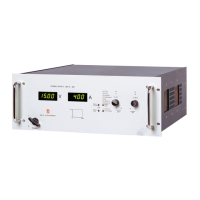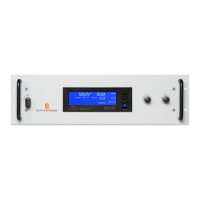Do you have a question about the Delta Elektronika SM 120-13 and is the answer not in the manual?
| Brand | Delta Elektronika |
|---|---|
| Model | SM 120-13 |
| Category | Power Supply |
| Language | English |
Evaluation of Delta Elektronika power supplies to installation category II (Over voltage category II).
Instructions for connecting the unit to AC power supply mains via a three conductor cable and grounding.
Guidelines for grounding DC power terminals, including warnings for voltages exceeding 60VDC.
Warning about potential electric shock from touching contacts or wires after disconnection.
Details on connecting the unit permanently or via an industrial type plug complying with IEC 60309.
Fuse replacement must be done by authorized Delta Elektronika service personnel only.
Advice against using AC supply exceeding the unit's AC input voltage and frequency rating.
Instructions for personnel regarding not removing covers or replacing components.
Parts substitutions and modifications are allowed by authorized Delta Elektronika service personnel only.
Steps for safely removing safety covers, emphasizing unit shutdown and capacitor discharge.
Safety warnings for handling and mounting the unit, including weight and sharp edges.
Information on air flow requirements, hot parts, and avoiding fan obstruction for cooling.
Warning about high currents and magnetic fields affecting electro medical devices like pacemakers.
Specifies operating conditions for safety approval, including usage, temperature, humidity, and altitude.
Explanation of symbols like caution for electrical shock and instruction manual symbol.
Guidance on responsible disposal and recycling of the product according to WEEE directive.
Details on constant voltage/current modes, autoranging facility, and output ranges for SM1500 series.
Information on the wide AC input voltage range and power derating below 120 VAC.
Explanation of active power factor correction (PFC) and electronically limited inrush current.
Information on low standby AC input power consumption.
Highlights high and constant efficiency over a wide DC output current range.
Details on CV-load regulation measured directly on DC power terminals.
Guidance for accurate CC-load regulation, avoiding external voltage sensing.
Describes low DC output ripple and how it's measured to avoid magnetic field interference.
Explains programming DC output voltage/current via external analog voltage (0-5V).
Method to prevent earth loops for programming by using an isolated source or ISO AMP CARD.
Details on programming and status monitoring using optional PSC controllers.
Describes monitor outputs providing 0-5V proportional to output current/voltage.
Information on the +12V output on the programming connector and its protection.
Explains logic outputs for status signals like DCF, ACF, OT, CC, LIM, and PSOL.
Details on the 2 status relay outputs connected to CON D for DCF and ACF relays.
Explanation of the functions of DIP switches 1-5 on SW1 at the rear panel.
Describes how to operate the Remote Shutdown function using voltage or a relay contact.
Explains the Interlock connector function to enable/disable the unit's DC output.
Discusses rise/fall times for programming and programming speed options.
Advice on handling pulsating loads to avoid DC output capacitor overheating.
Details on insulation tests performed on the separating components like transformers.
Describes RFI filters on mains input and DC output for low conducted RFI and clean output.
Specifies operating temperature range and current derating above 50°C.
Explains thermal switch function that shuts down output on overheating.
Discusses hold-up time dependency on load and DC output voltage.
Information on the turn-on delay for the DC output voltage.
Details on the electronically limited AC inrush current and its overheat potential.
Explains remote sensing for constant load voltage and its precautions.
Details on connecting power supplies in series up to 600V, recommending Master/Slave.
Information on paralleling units without limitations, recommending Master/Slave.
Explains how to use units as building blocks for larger systems via Master/Slave configuration.
Describes Voltage and Current Limit features for circuit protection and safe preset values.
Details on front panel controls, including analog potentiometers and optional digital encoders.
Explains the low-noise blower cooling system and its dependence on internal heatsink temperature.
Provides the physical dimensions of the unit, including length, width, and height.
Guidance on humidity and condensation, advising to avoid condensation inside the unit.
Details operating temperature range, storage range, and airflow requirements.
Instructions for mounting the unit in a 19-inch rack, including slide and screw recommendations.
Step-by-step guide for initial unit operation, including checks and settings.
Explanation of the Keylock function and how to activate/deactivate it.
Details on selecting the start-up mode for units with magnetic encoders (Option P220).
Instructions for analog programming using voltage sources connected to CON E.
Instructions for isolated analog programming using the ISO AMP CARD or CON H.
Details on programming via IEEE488/RS232 using PSC controllers and CON F/G.
Description of the 5V monitoring outputs compatible with most interfaces.
Information on status outputs with a separate Ø connection to avoid unwanted offsets.
Detailed guide on DC load sensing, including connections and precautions.
Explains the suitability of CV/CC regulated power supplies as ideal battery chargers.
Instructions for operating Remote Shutdown via voltage or relay contact on CON E.
Steps for connecting units in series using Master/Slave configuration with RJ45 cables.
Guide for connecting units in parallel using Master/Slave configuration with RJ45 cables.
Notes on Master/Slave and parallel operation for high speed programming units.
Example of connecting units in mixed series/parallel configurations using adapter.
General advice for troubleshooting, including contacting support and using the RMA-form.
Troubleshooting steps for units with no DC output when operating in manual control.
Steps to troubleshoot programming issues, including checking fuses and programming offsets.
Explains causes of programming offsets like earth loops and solutions.
Troubleshooting guide for failures in status outputs, checking fuses and connections.
Troubleshooting common issues in Master/Slave parallel operation, focusing on wiring.
Steps to resolve issues where DC output voltage exceeds the set value.
Troubleshooting the OT LED being on, indicating internal heatsink temperature is too high.
Troubleshooting the OT LED blinking, indicating rising heatsink temperature.
Troubleshooting the ACF LED being on, indicating low or intermittent input voltage.
Troubleshooting the DCF LED being on, indicating voltage below set point or interlock issue.
Troubleshooting the PSOL LED being on, indicating Power Sink overload or high temperature.
Explanation that blinking LEDs indicate the Keylock function is activated.
Troubleshooting when no LEDs are on, checking input and seeking repair.
General advice for persistent problems, including using the RMA-form.
General statement that power supplies need no maintenance or calibration, but cooling must not be obstructed.
Details on cooling fan operation, dust buildup, and thermal protection.
Recommendations for using power supplies in aggressive galvanic industry environments.
States power supplies are factory calibrated and need no further calibration unless special situations arise.
Instructions for calibrating digital meters using specific potentiometers.
Details on special calibrations for qualified personnel only, like current monitor offset and range.












